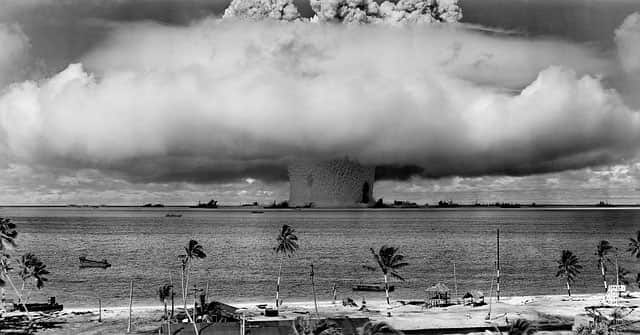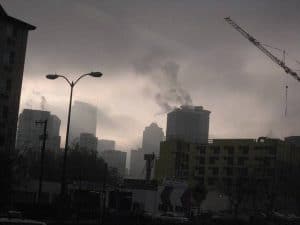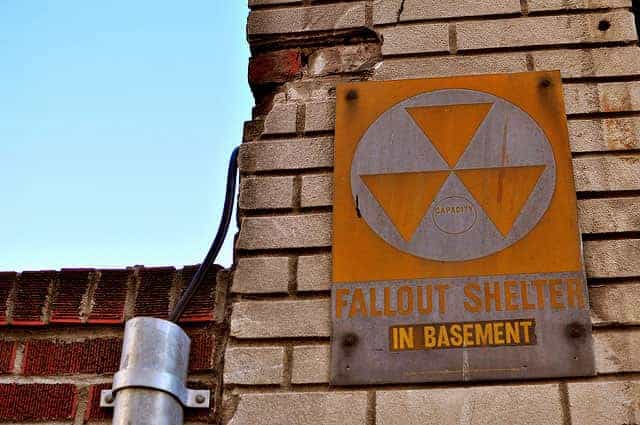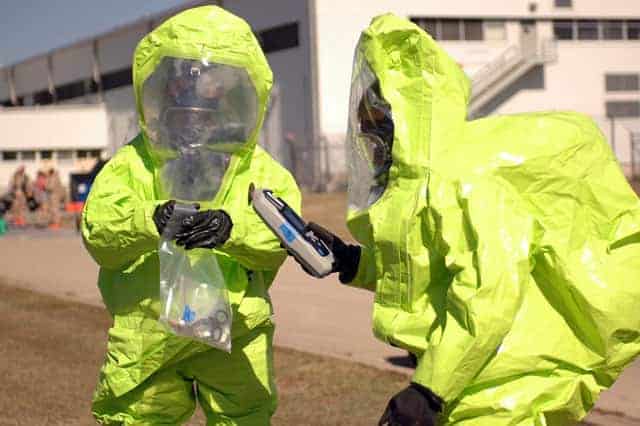I don’t want to get into the politics of whether a nuclear war will happen. However, if it does happen, everyone should be prepared – which is why everyone should have a nuclear survival kit at home.
What Happens During a Nuclear Attack?
If you are caught at Ground Zero of a nuclear attack, don’t count on surviving. A one-megaton hydrogen bomb would make a huge crater at the site. Every structure within a two-mile radius would be destroyed.
The temperatures would rise drastically from the nuclear bomb. At the center, temperatures would reach 500 million degrees Fahrenheit – vaporizing everything. People five miles away would be burned.
There would also be other immediate effects that make nuclear survival unlikely, such as firestorms raging as the oxygen is consumed from the air. The rising heat would cause hurricane-strong winds that would spread the fire further.
It would be theoretically possible to survive even close to the center of a nuclear blast. You’d need a structure that could withstand 50 pounds per inch and mostly need to be underground. However, when talking about nuclear survival kits, we are usually talking about surviving nuclear fallout.
What Is Fallout?
The biggest threat to nuclear survival is fallout. Nuclear fission creates many types of radiation. None are “safe,” but gamma rays and neutrons are the most problematic.
Gamma rays and neutrons are much more deadly than the actual nuclear blast! Over time, they would kill more people – including those far outside the blast site.
In the event of a land detonation, the particles of earth become radioactive and are thrown into the sky, forming a mushroom cloud. These radioactive particles eventually return to the ground, hence the name fallout.
A nuclear bomb that gets detonated in the air is much worse than a land detonation. It won’t produce an ominous mushroom cloud, but the radioactive particles are released into the air. The wind carries them, and they fall on the earth in a much larger radius.
The Risks of Fallout

Fallout exposes us to radiation. That radiation causes changes to our cells on a chemical level, altering DNA.
This can lead to issues like:
- Cancer
- Congenital disabilities in children
- Infertility
- Nausea and vomiting
- Diarrhea
- Cataract
- Hair loss
- Loss of blood cells
Radiation exposure is measured in rems (Roentgen equivalent man). On average, people are exposed to 0.62 rem of radiation per year.
Once you start getting into exposure, amounts of over 100 rem health risks are seen, but nuclear survival is likely.
Levels of 200-400 rems mean illness and likely mortality. At 600 rems, death is likely from internal bleeding within 2 to 12 weeks. The US military believes that levels of 8000 rems will cause immediate death.
Fallout Does NOT Have to Mean Death
One of the biggest myths about nuclear fallout is that it would destroy the earth and everyone in it.
While immediate contact with large amounts of fallout would signal death, you’ve got to remember that nuclear particles degrade fairly quickly. There would still be a higher risk of cancer and congenital disabilities in areas near the blast site, but this risk would subside.
Just look at Hiroshima – their cancer risks from 1958 to 1987 weren’t much higher than areas in Japan not hit by the bomb.
I mention this to get across an important point:
Expert Tip
Fallout is most dangerous immediately after a nuclear blast. Don’t try to flee. Take cover to avoid exposure.
Potassium Iodide Tablets for Nuclear Fallout
Potassium iodide is a salt. When taken, it floods the thyroid and prevents the thyroid gland from absorbing radioactive iodine. Thus, potassium iodide tablets will protect you from getting thyroid cancer and other thyroid diseases due to fallout. (Read about the shelf life of iodine)
But potassium iodide is not a magic pill against the effects of fallout! It only protects the thyroid and will not protect the rest of the body from absorbing radiation.
View potassium iodide tablets on Amazon.
You should have potassium iodide tablets as part of your nuclear survival kit – don’t think you can take them and then walk safely through radiation.
The best protection is still shelter and time.
Nuclear Winter Scenario

One of the fears of nuclear warfare is the risk of a nuclear winter. This theory states that a nuclear bomb would cause such large clouds of radioactive material in the atmosphere that it would block sunlight.
The result would be darkness, preventing photosynthesis and destroying the food chain, resulting in mass extinction.
Unfortunately, this is one of those scenarios we can do little to prepare for. You could aim to have a year’s stockpile of food and water in your nuclear survival kit. However, you’d also have to develop a comprehensive plan for protecting that stockpile.
Go for it if you can afford a secure underground bunker large enough to hold enough food to last through nuclear winter.
Otherwise, focus on doing what you reasonably can to secure your safety.
Nuclear Blasts and EMP Risk
Electromagnetic Pulse or EMP is one part of the nuclear risk that gets glossed over.
When nuclear bombs are detonated, the electrons start going incredibly fast. This creates a short but powerful magnetic field (EMP). The EMP isn’t dangerous, but it destroys electronics such as telephone wires, electrical plants, radios, and electronic devices.
EMP is so strong that the Star Fish Prime nuclear tests caused electrical disruptions more than 900 miles away!
Our entire society relies on electrical devices to function. There would be no electricity. You wouldn’t be able to get info from your emergency radio. No internet. Heck, even your car probably wouldn’t work!
If you don’t know much about EMP, I suggest you read these articles:
- What Is EMP?
- First, 4 Steps to Take After EMP
- What is a Faraday Cage and How It Protects Against EMP
Protecting Yourself from Fallout – Don’t Flee!
The most important thing to remember about surviving nuclear fallout is not to flee. While this goes against our instinct, the amount of fallout in the air is the highest right after a nuclear detonation.
If you were to flee immediately, you’d expose yourself to high radiation levels, which could quickly kill you.
By contrast, if you seek shelter, you could avoid much of the fallout and stay safe.
FEMA and the Department of Homeland Security recommend going as far below ground as possible or into the center of a tall building. The goal is to get as much material (concrete, brick, soil, etc.) between you and the radioactive material. The material is a barrier that the radioactive particles have to get through.
In 2010, a nuclear exercise called Operation Golden Phoenix tested what would happen during a nuclear attack in Los Angeles. The findings showed that 285 thousand people would die or get radiation sickness – but 84% of these could be avoided if people just went to their basements or another shelter.
Read how to find a nuclear fallout shelter near me
Nuclear Fallout Shelters

If you want to take nuclear survival to the next level, you’ll get a fallout shelter.
Many build nuclear fallout shelters in their backyards because the ground provides protection. However, having your fallout shelter in your basement is probably best because you wouldn’t have to run outdoors (and expose yourself to fallout) to access it.
If you are considering a fallout shelter for nuclear survival, know they are rated in PF (Protection Factor). A nuclear fallout shelter should have a PF of at least 40. That means you’d only receive 1/40th of the radiation found outside.
How Long Does Nuclear Fallout Last?
There is only so long you can hunker down in your shelter after a nuclear detonation. At some point, you will have to flee to safer ground.
Unfortunately, there is no good answer to how long fallout lasts first because we don’t have much research on the topic. Second, it would vary depending on the size of the blast and factors like the weather.
In general, though, fallout radiation degrades quickly. It will be around for years but won’t be so intense. The biggest threat is during the first two weeks. After two weeks, it will have declined to approximately 1% of its initial radiation level.
Nuclear Fallout Radius
During the 15-megaton nuclear test at Bikini Atoll in 1954, the blast caused contamination across more than 7,000 miles. That’s 20 miles upwind and 350 miles downside.
That was during a ground test. An air detonation would cause nuclear fallout to span a much higher radius.
Again, there is no exact way to calculate a nuclear bomb’s fallout radius. We can’t predict the size of the bomb or wind patterns.
What you do need to know is to stay put for as long as possible. When necessary or authorities tell you to evacuate, get far from the blast zone – and get away quickly!
One more reason to have your Bug Out Bag packed and a Bug Out vehicle ready.
It might seem overkill, but a hazmat suit will help protect you from radiation when it is time to flee! While you’re at it, wear the hazmat suit in your shelter to protect yourself.

Protecting Your Food and Water from Fallout
Though there isn’t too much conclusive research on the subject, the general expert consensus is this:
Sealed food and water would be safe to consume after nuclear fallout.
Ideally, this would be non-perishable food and bottled water stored in your shelter, protected from potential fallout. If you had to take food and water from outside, you’d need to carefully clean the containers to remove any fallout.
You would not want to forage for food, garden, or hunt after nuclear fallout. Those food sources would likely be contaminated for a long time.
Removing Radionuclides from Water
If you run out of bottled water, your best water source would be from deep wells and covered reservoirs. You’d need to treat this water against pathogens like bacteria and parasites. That could quickly be done with a survival filter.
But no water filter is going to remove radionuclides from fallout-contaminated water!
The only way to remove radioactive particles from water is to use reserve osmosis or ion exchange.
Read More About Storing Water in Emergencies.
Nuclear Survival Kit Checklist
Even if you aren’t worried about nuclear survival, you should still have an emergency kit packed for hurricanes, earthquakes, blackouts, and other disasters. In addition, you need to have a communication and emergency plan in place.
The items in the nuclear survival kit checklist below are specifically for protecting you from fallout and staying alive while hunkering down. Don’t wait until it is too late to prepare for nuclear survival!
- Bottled water
- Non-perishable food
- Designated shelter
- Emergency radio
- Blackout kit
- Emergency heating
- Emergency toilet
- Hazmat suit
- Geiger Counter (helps you know when it is safe to evacuate – see our guide to the best Geiger counter)
- Emergency mask (N95 mask)
- Change of clothes (in case yours get contaminated)
- Gloves – for handling any contaminated items. (read about the best survival gloves)
- Sealable bags (for contaminated items)
- Soap and way to scrub yourself clean
- First aid kit
Key Takeaways on Nuclear Survival:
1. Take Shelter
- Build an underground nuclear survival shelter if you can.
- Alternatively, build a bunker in your basement or an interior room of your home.
- If you can’t build a shelter, take cover in your basement or crawlspace for protection.
2. If Away from Home When Nuclear Blast Occurs
- If you are away from home when the blast occurs, take shelter IMMEDIATELY.
- Make a list of potential shelters near your home, work, school, and other places you frequent.
- Do not attempt to get your children from school – it will only expose you and them to more fallout.
- Clean your entire body (including inside ears and nose) with soap and water to remove nuclear particles. Do not use conditioner or skin creams, as these will bond to radioactive particles.
3. Evacuation
- Use your emergency radio to find out when it is safe to evacuate
- Do not leave your shelter under any conditions during the first 24 hours.
- After 24 hours to 2 weeks, evacuating to an upwind location should be safe.
Are you preparing for nuclear survival? How?
https://www.quora.com/Why-doesnt-the-blast-from-a-nuke-take-place-on-the-ground
https://www.nrc.gov/about-nrc/radiation/around-us/doses-daily-lives.html
https://public.websites.umich.edu/~jmoilane/nuclear/Fallout.html
https://www.nrc.gov/about-nrc/emerg-preparedness/about-emerg-preparedness/potassium-iodide/ki-faq.html
https://www.oism.org/nwss/s73p912.htm
https://home.howstuffworks.com/home-improvement/household-safety/tips/fallout-shelter2.htm
https://www.atomicarchive.com/Effects/effects19.shtml
https://www.cnduk.org/campaigns/global-abolition/effects-of-nuclear-weapons
https://www.livescience.com/23423-nuclear-explosion-beer.html



What about food and water survival for afterwards?
You present some very valuable information here. However, a semantic in the face of a nuclear explosion, is that fallout is much more prevalent with ground blast than air. The reason for this is the debris drawn into the cloud becomes highly radioactive and carries much father. Airburst mostly remains in the upper atmosphere where most of the isotopes decay (few exceptions)due to their short half-life.
My background is a 30-year industrial hygienist and safety professional in the Department of Energy. Specifically, Sandia National Labs, Los Alamos National Labs, Paducah Gaseous Diffusion Plant, and Nevada National Security Site.
I’m late to the party, however, I have a few thoughts on this subject. Many of the suggestions posted here are right on the dot. I have had to prepare for mass-casualty scenarios at our medical center (I’m an RN, soon-to-be NP). There are many ways that our environment can be terribly unhealthy, and definitely dangerous. Being prepared does not need to be costly. Buying 1-2 items at a time, or trading with others to make a “doomsday” box can be practical. Many people think prepping is for the crazies…until us crazies are the only ones with drinkable water, sanitary conditions, rations up the wazoo, and protection from the elements.
Having anything ready for a certain situation, such as a natural disaster, is wise and possible, no matter who you are. I have told many people that the one thing your average person does NOT have is a PLAN. Waiting til the last minute to pack a bag, or find a safe spot, or a storm shelter, etc-is what makes people panic and act stupid. Then people die.
Making a plan is free. Knowing where to go in the off chance your home is not safe, or if you’re away from your safe spot is crucial. Our safety drills at work really push everyone to have a job, task, or function in an emergency. They also tell us to get the hell out of everyone’s way if we’re helpless or ineffective. So, the point here is MAKE A PLAN and be ready to DO SOMETHING or die. Simple as that.
With respect to mask selection… (And speaking from extensive training and experience in the handling and management of high hazard material including mixed wastes as well as chemical and biological materials)
1) Facial hair is a recipe for failure. You cannot get a correct seal between the mask and your face if it is interrupted by facial hair. As little as a two day beard is enough.
2) As a minimum I would suggest a Full Face Cartridge Air Purifying Resprator equipped with Organic Vapor / Acid Gas and HEPA filter (these are marked with a yellow and magenta stripe). Adding a prefilter over the top of the cartridge(s) is advisable as it will extend the cartridge life.
The mask should be properly fitted to the user by a competent trained individual. Not all masks are one size fits all, and fit is everything when it comes to protection. The fit should include at a minimum a test with irritant smoke (you don the mask, put a hood over your head and the test is performed by using an irritant smoke aimed at the face seal. If you have a leaky seal it will be obvious in no time at all.)
A final thought… If you can’t protect yourself, you certainly can’t protect anyone else….
Mr. Clayton wrote “Life After Doomsday” has gone thru several editions, and is still available for ca $15 on the net. The best thing about it is that it is pretty readable by the average person (I think, and I might not be the best judge of that…).
A good general tome, a bit dated, but still covers the majority of the issues…
info on his credibility here: https://en.wikipedia.org/wiki/Bruce_D._Clayton
More ?’s than comments. I have noticed that some water filters say they can filter
radiated particulate matter, wouldn’t that cause the filter medium to become radioactive and thereby become a danger onto itself? Again if distillation is used to
separate particulate radiated matter wouldn’t the dirty water container also become
radioactive? Any enlightened answers would be welcome?
Stick head between legs and kiss ass goodbye
That is one option Dwight! We like to be a little more pro-active though and make sensible preparations for these scenarios.
Hey guys, great post. I am glad you covered the hazmat suit as they are ridiculously cheap (less than $10) and easy to hold.
I should also point out, with the hazmat suit, they are prone to tearing quite easily, and if there ever is a blast, I imagine there could be a likely chance you might rip it on something. One thing to do is carry a roll of duct tape as it works great as a way to band-aid up a suit. The shoes on those hazmat suits are always a little bit soft. It is common practice for NBC drills and scenarios to duct tape the joins between the suit and thick butyl-rubber boots and gloves to avoid contamination.
There is also the necessity of an NBC/CBRN-rated gas mask. But I won’t fill up your comments section!
Let me know what you think!
While this reply is not meant to rain on survival options which might be thinkable following a nuclear war, about the only thing that will most probably still be around after such a war is the earth itself, aside from that , all bets are off.
For instance, should a nuclear war of any substance occur during the dry months in the Northern hemisphere, the fires that would ensue would probably render all breathable air non-existent. Last summer for instance, even though there were at least 10,000 fire fighters engaged in putting out fires in North America, much of the continent’s air was occasionally toxic enough to cause serious breathing problems for many people. We live in the Okanagan Valley for instance, an area in British Columbia where our home is only a few hundred feet from Okanagan Lake, about 100 miles in length. As such, for much of the summer season, we were unable to see to the other side of the lake, only about 2 miles wide on average for most people living on its shores. The air quality at times exceeded dangerous levels for at least 25% of the summer season, and all of this with relatively few forest fires not being aggressively battled by 10,000 fire fighters.
If one multiplies a few hundred large cities burning on the North American continent all at once, with no firefighters present to battle them , plus the fires that would ignite from various sources in the wild, with no fire fighters involved, I would seriously wonder if the air itself would be breathable in most areas of the continent, if not globally. The same conditions would of course exist in Europe or Asia as a full-scale nuclear war would involve many, if not most larger cities on the planet. When Carl Sagan wrote about ‘Nuclear Winter’, a scenario in which only a few hundred nuclear bombs were involved, Sagan never once mentioned that the air may well become non-breathable, a factor which he did not even consider.
In conclusion, should you have read any of the above, and if my observation of the conditions that were present in our neck of the woods last summer are any indication of things to expect with wild fires, no amount of preparation will prevent the death of billions, if not our entire species in as little as only a few months, or a few years at the very most.
Just sayin….
Thanks for this very interesting reply. I think you are probably correct in the event of an all out global nuclear war.
A more likely scenario is a localized disaster such as a reactor meltdown for which we can take steps to prepare ourselves and improve our chances of survival.
Would love to hear other readers opinions.
Yep.
I am writing from Ballarat Australia February 8th 2024 where the threat of nuclear war is very real .
My advice is to build underground survival shelters with food for several years. Make this your home guys. Get used to it. The US are bickering with Iran and Iraq. Russia is at war with Ukraine, Jews are at war with Palestinians…. You want more???
A dosimeter, or some type of radiation counter would be a life saving device. There are cards which can be hung around the neck that show the total amount of radiation you have been exposed to.
Morbidly, if you are alone and it is apparent that you are going to die, have a plastic bag for your own body. Crawl into it leaving only enough opening to breathe your last breaths from. this will help somewhat for the removal of your remains when you are eventually found. It won’t do you much good but it will help others. If you are a true prepper, consideration of your fellow man is already high.
Semper Fi!
Washing off a Hazmat suit would be difficult, going in and out of a shelter when it is safe to go out for short periods of time. We have a bunch of these for initial cleanup outside, to be removed and put into a disposal container outside of the shelter, but in a containment room next to it.
https://www.amazon.com/DuPont-TY122S-Disposable-Elastic-Coverall/dp/B0008F4HPQ/ref=as_li_ss_tl?s=hi&ie=UTF8&qid=1503069384&sr=1-4&keywords=tyvek+suit&linkCode=ll1&tag=nuc-surv-kit-20&linkId=b2eca19aebee8f7da1aa6d5257f05c70
Good tip! Appreciate it.